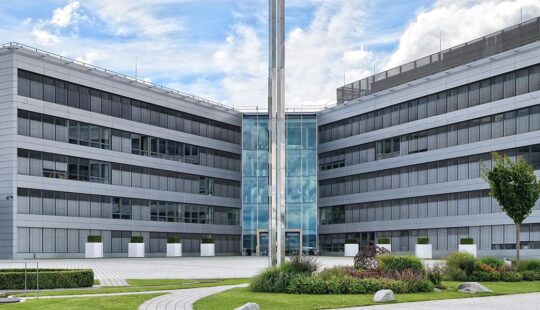SAP co-founder Dietmar Hopp once said about co-founder Hasso Plattner: “It’s hard to quantify his legacy. All I can say is that without him, SAP would never have been so successful.” At the 2024 Annual General Meeting of Shareholders on May 15, Plattner will step down from the SAP Supervisory Board after 21 years as its chairman.
One need only look at the key milestones in Plattner’s 52-year career at SAP to gain a vivid picture of his legacy. Together with Dietmar Hopp and his fellow co-founders, Plattner created the market for real-time business software, helped steer SAP through more than five decades of fast-moving IT history, and drove SAP’s global expansion – transforming it from a single-product company to the world’s No. 1 provider of enterprise applications.
Over the years, he worked tirelessly to open new horizons for the company and its employees, identifying technological trends and channeling his pioneering spirit into revolutionizing far more than just data management.
1972-1973: The Early Days
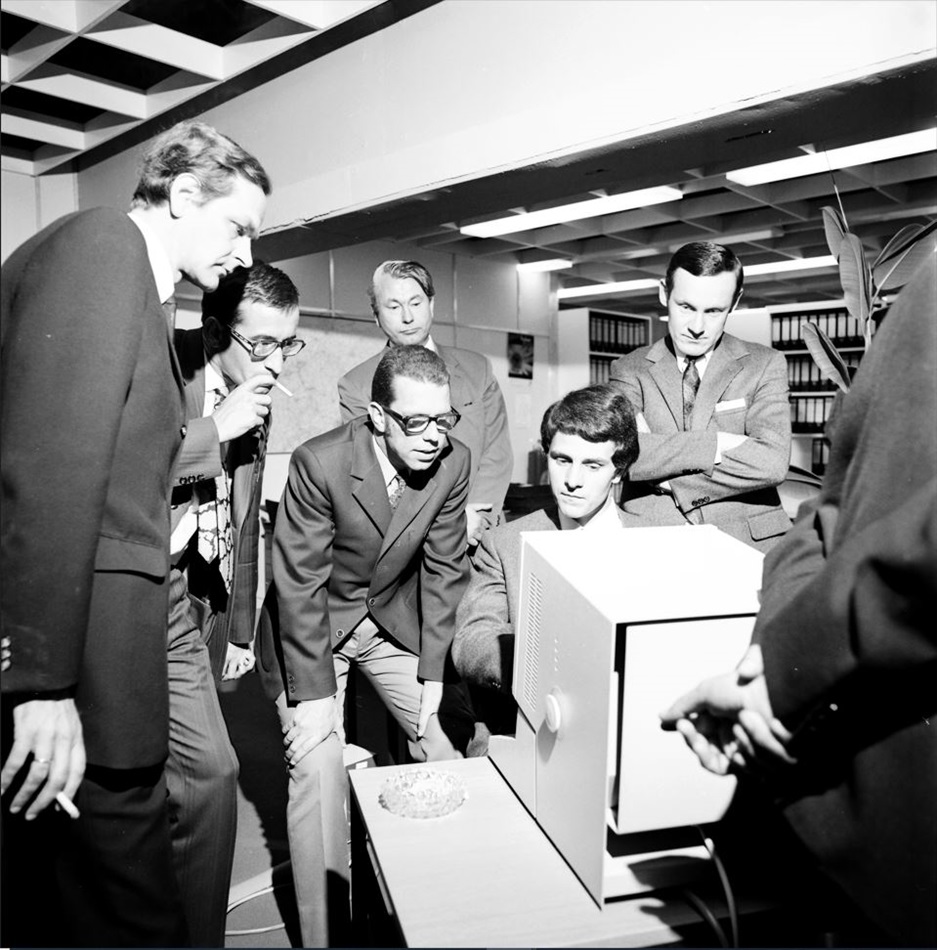
Having created Germany’s first real-time software application with a user interface, Hasso Plattner and Dietmar Hopp founded a company they named Systemanalyse Programmentwicklung (“System Analysis Program Development”) on April 1, 1972, together with their IBM colleagues Claus Wellenreuther, Klaus Tschira, and Hans-Werner Hector.
In 1973, the entrepreneurs launched RF, their first financial accounting system. The “R” in the name stood for “real time.” Developed under Plattner’s leadership, RF laid the foundation for a series of software modules in a system that would later be known as SAP R/1.
“Before I worked on RF,” Plattner once said, “I knew nothing about financial accounting; afterwards, I could hold seminars about it for CFOs. And not because I’d read stacks of books or was very smart, but because I’d learned from customers how to build this kind of system. I worked side by side with our customers at their offices every day.”
1976: The Formative Years
Systemanalyse Programmentwicklung was renamed “SAP.” Each of the founders and their employees – numbering about 30 at this point – was a developer, salesperson, and consultant all rolled into one.
Hasso Plattner and Dietmar Hopp were constantly competing to be the best at programming and selling their products. Plattner recalls that it made him really mad once when Hopp sold more than he did. Wherever their tasks and skills converged, they would engage in a private, “take-no-prisoners” contest to outdo each other.
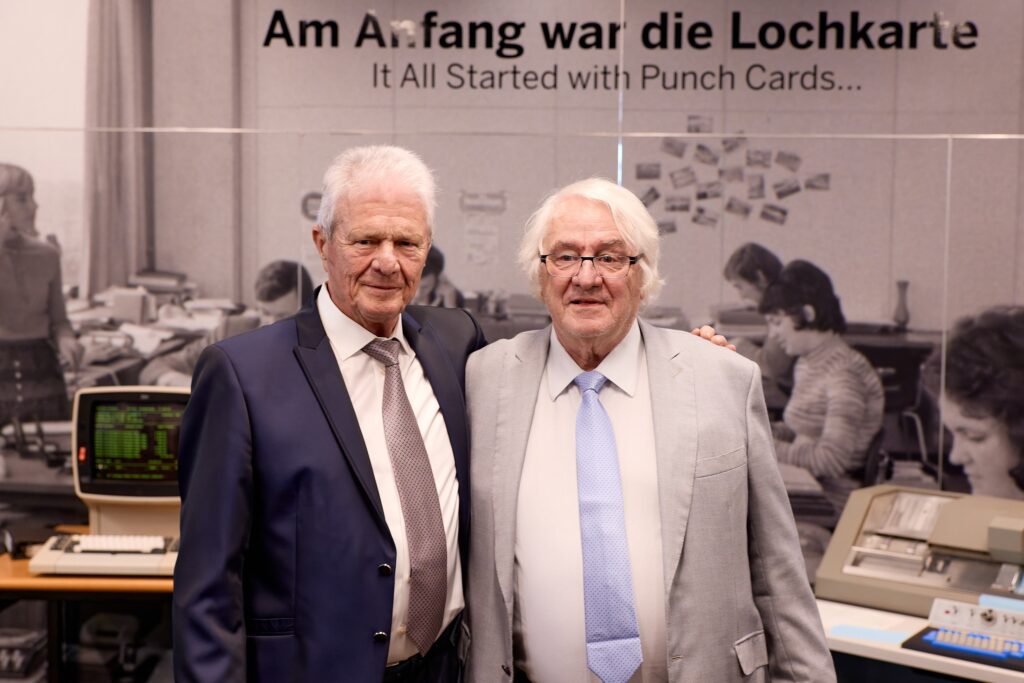
Nevertheless, both men also knew how to harness their ambition and fondness for friendly competition to the benefit of their fledgling business.
1988: Conversion and IPO
SAP GmbH was converted to a stock corporation, SAP AG, and in October 1988 it listed on the stock exchanges in Frankfurt and Stuttgart, providing the company with the funding it needed to expand into even more markets.
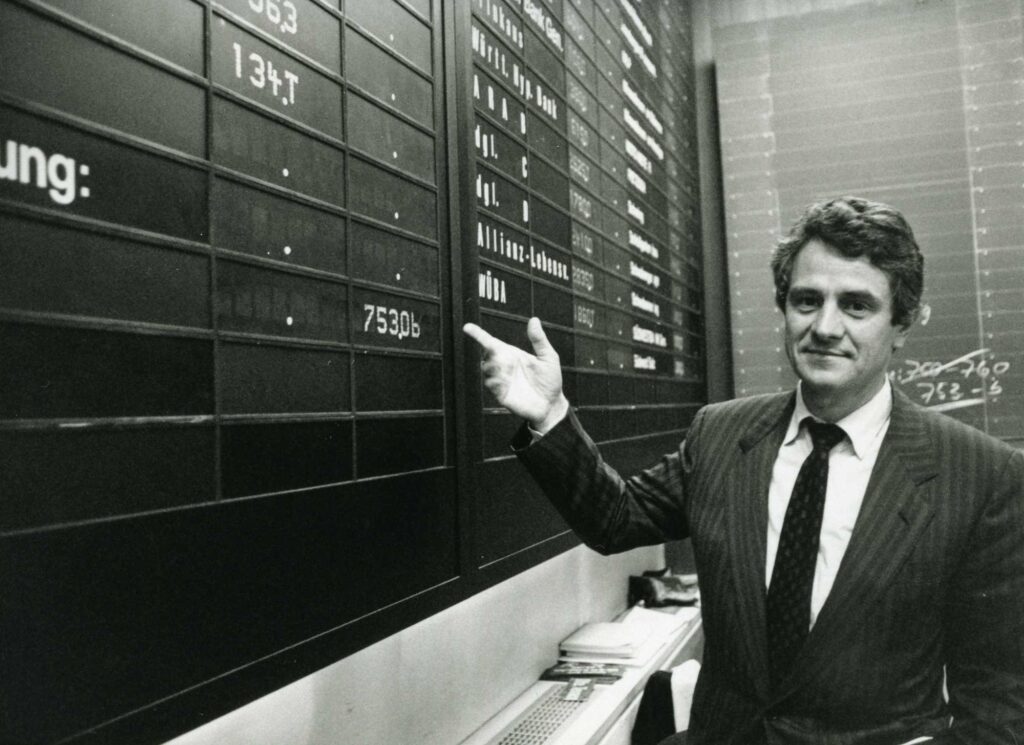
1991: SAP R/3
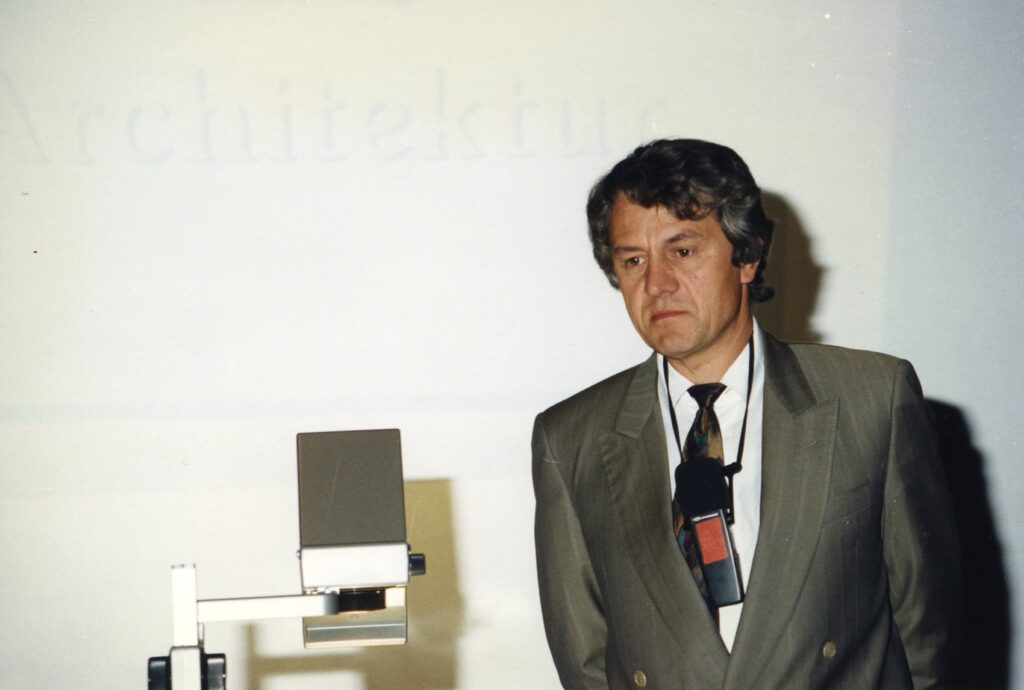
At SAP’s 25th anniversary celebrations in 1997, Plattner recounted an incident in late January 1991, which he described as “probably the most dramatic situation” in the company’s history: “A year before the final delivery date for R/3, we realized during testing that its performance on our mainframe was completely unsatisfactory and that the test conditions were unacceptable. Six weeks before we had planned to present R/3 at the CeBIT trade fair in Hanover, we had all but given up on the project.
We called an emergency meeting at which everyone remained standing, such was the urgency of the matter at hand. We decided to halt work on the mainframe systems and, in a last-ditch attempt, to switch to the new, more powerful Unix workstations, which we’d previously only used in development.
The presentation of R/3 on Unix was a huge hit. A year and a half later, we began shipping our new client-server software to customers. That was the start of R/3, a business application for network-based computers.”
1992: Heading Stateside
In the early 1990s, when everyone else’s attention was focused on getting SAP R/3 to market quickly, sales of SAP R/2 in Germany were a cause of concern for Dietmar Hopp. As Plattner recalls: “Dietmar and I were standing in his office, and he said to me, ‘It’s not looking good. The only option I can see is for you to pack the system up and take it to America.’” They agreed to continue promoting the SAP R/2 mainframe software in Germany while going all-in on SAP R/3 in the U.S.
At the Sapphire customer conference held in Orlando in September 1992, Plattner announced that SAP would deliver the SAP R/3 system within six weeks to anyone who ordered it there and then. By October, computer manufacturer Convex had signed a contract for the new product, giving SAP its first SAP R/3 customer in the United States. And when, not long after that, oil giant Chevron – one of the country’s largest companies – also opted for R/3, SAP’s new software, originally built with the midmarket in mind, was well on track to becoming a global success story.
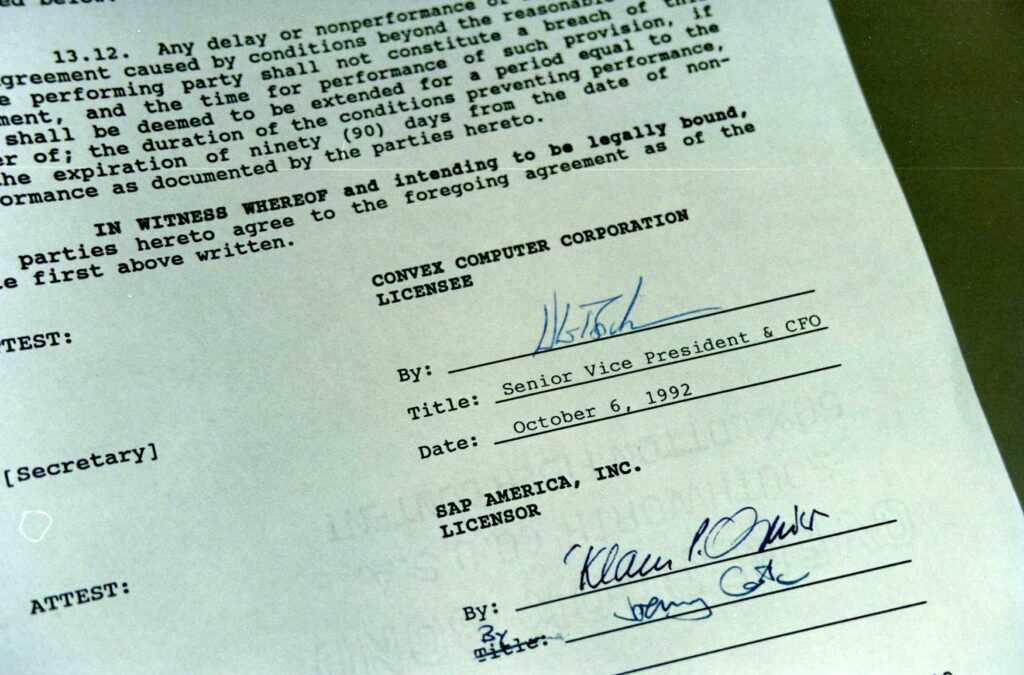
1993: A Very Special Partnership
SAP entered into an alliance with the world’s largest software company: Microsoft. Bill Gates, who had flown into Munich to sign the contract in person, told the audience at the press conference announcing the partnership: “We are delighted that SAP, one of the leading providers of standard software, supports Microsoft’s client-server operating system. We believe that many businesses will see this move by SAP as a compelling reason to opt for Windows NT.”
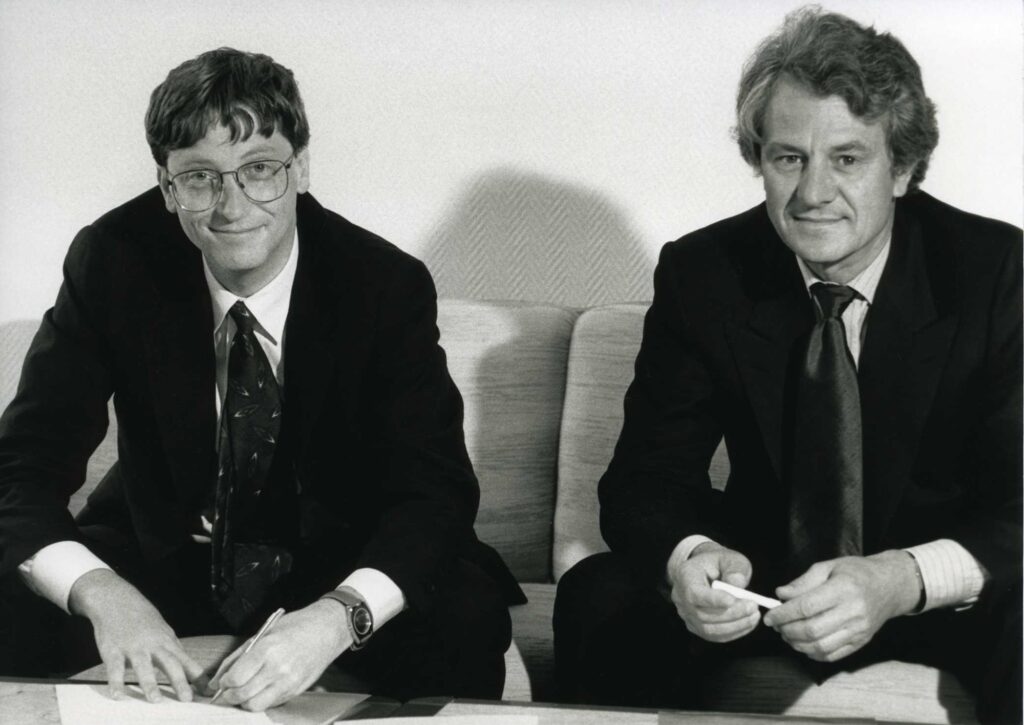
And when, in 2010, Plattner received the Transatlantic Partnership Award, Gates had this to say about his friend and colleague: “I’ve known Hasso for more than three decades. His knowledge, energy, and vision never cease to impress me.”
1997: SAP Celebrates Its 25th Anniversary
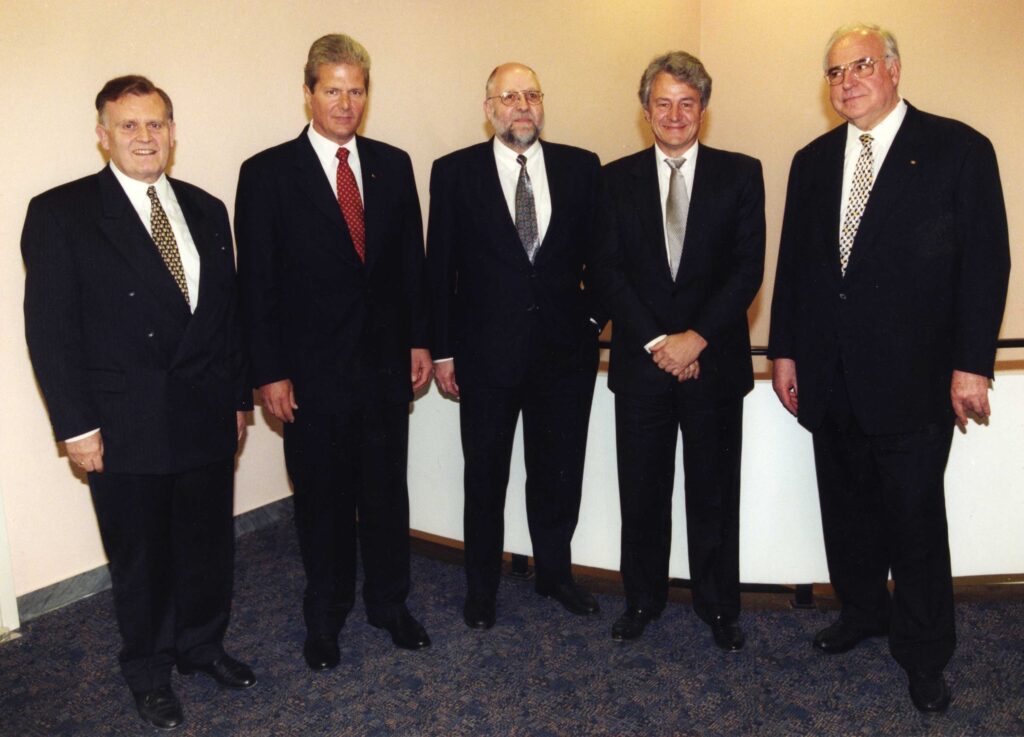
Plattner was appointed co-CEO, alongside Dietmar Hopp. In his speech at SAP’s 25th anniversary celebrations, he spoke about what had helped the company prosper: “Product focus is one pillar of SAP’s success. When a product sells well, the employees share in that sense of achievement. That feeling is just as important to them as the pay they take home each month. Our employees identify with the product – that’s why they have always gone the extra mile. No matter how different our views at times were, we always managed to regroup and we never lost sight of the product. For the past 25 years, the founders and employees of SAP remained true to the original product vision and never veered off course.”
1998: SAP Conquers New York
On August 3, 1998, the company debuted on the New York Stock Exchange (NYSE), the world’s largest exchange. CEO Hasso Plattner described SAP’s Wall Street listing as “a strategic necessity and logical milestone in the history of SAP.”
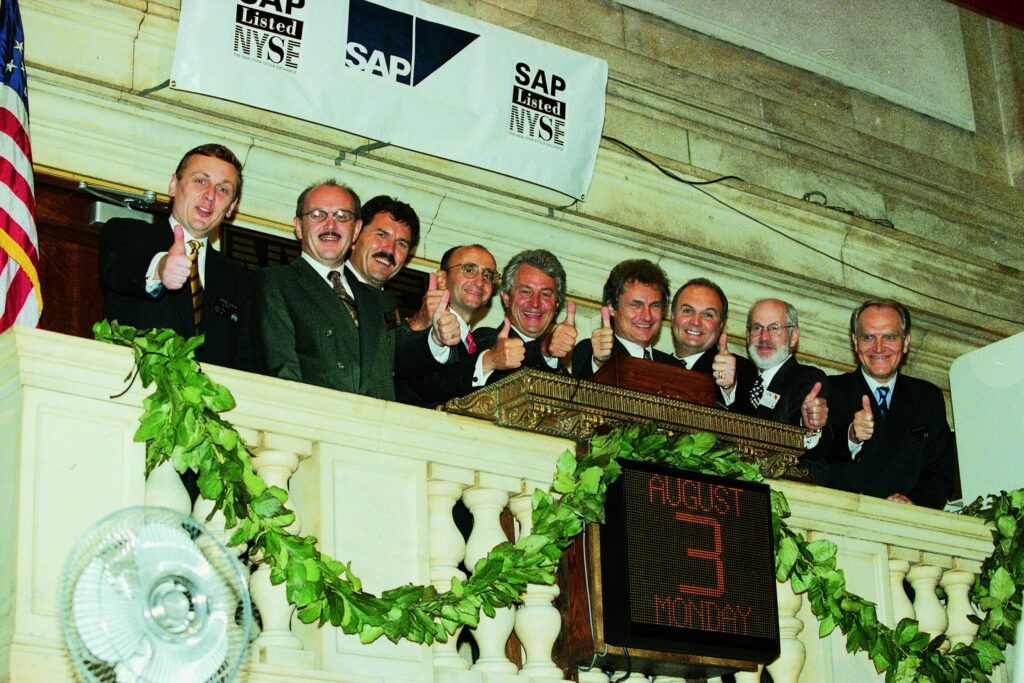
That same year, Plattner founded the Hasso Plattner Institute (HPI) for Software System Engineering in Potsdam, near Berlin. “The institute here in Potsdam is my contribution to training internationally competitive junior managers who help shape and advance the digital world,” he said.
Dietmar Hopp and Klaus Tschira transitioned from the Executive Board to the Supervisory Board, and Plattner became co-CEO alongside Henning Kagermann.
1999: The mySAP.com Revolution
In May, Plattner announced the mySAP.com strategy, which set the company and its product portfolio on an entirely new path. Using the latest Web technology, mySAP.com connected e-commerce solutions with the company’s existing ERP applications.
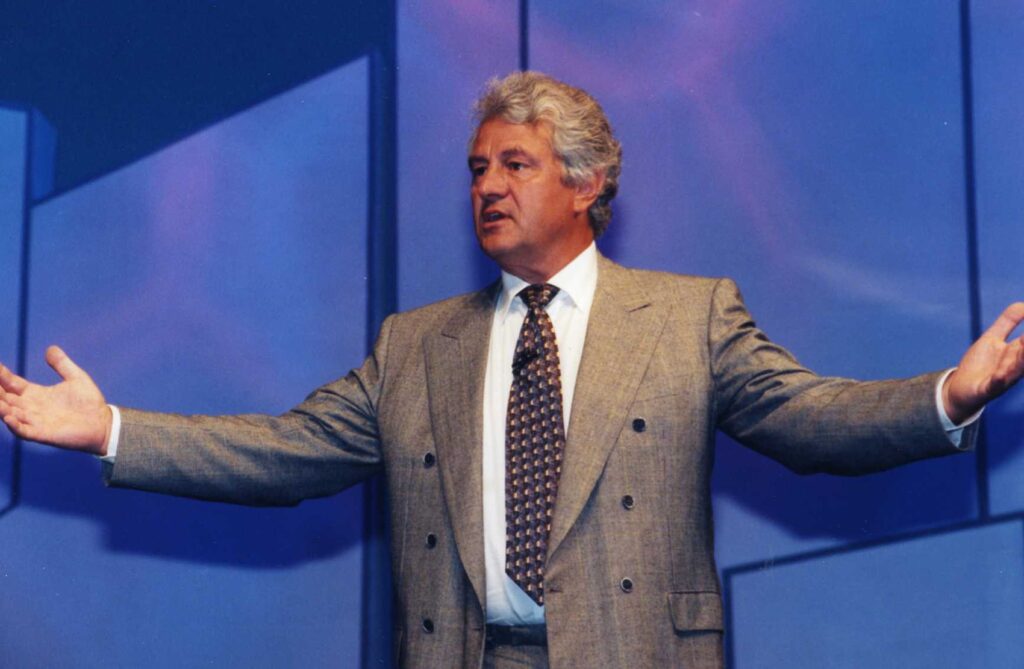
According to Plattner, success on the Internet was key to the company’s survival. At the Sapphire conference in Philadelphia in September 1999, a live demo of mySAP.com — with a prelude by Plattner playing Queen’s “I Want to Break Free” live on electric guitar — was enough to convince customers to adopt SAP’s Web strategy.
And, true to form, Plattner was already thinking about where the technology would go next, predicting that e-commerce and the hosting of applications on SAP servers would be “the future of software sales.”
2003: From Executive Board to Supervisory Board
Plattner stepped down from the Executive Board and was elected chairman of the Supervisory Board.
Speaking at the Annual General Meeting of Shareholders in May, he said: “This rising star of the 90s is now playing in the same league as IBM, Microsoft, and Oracle.”
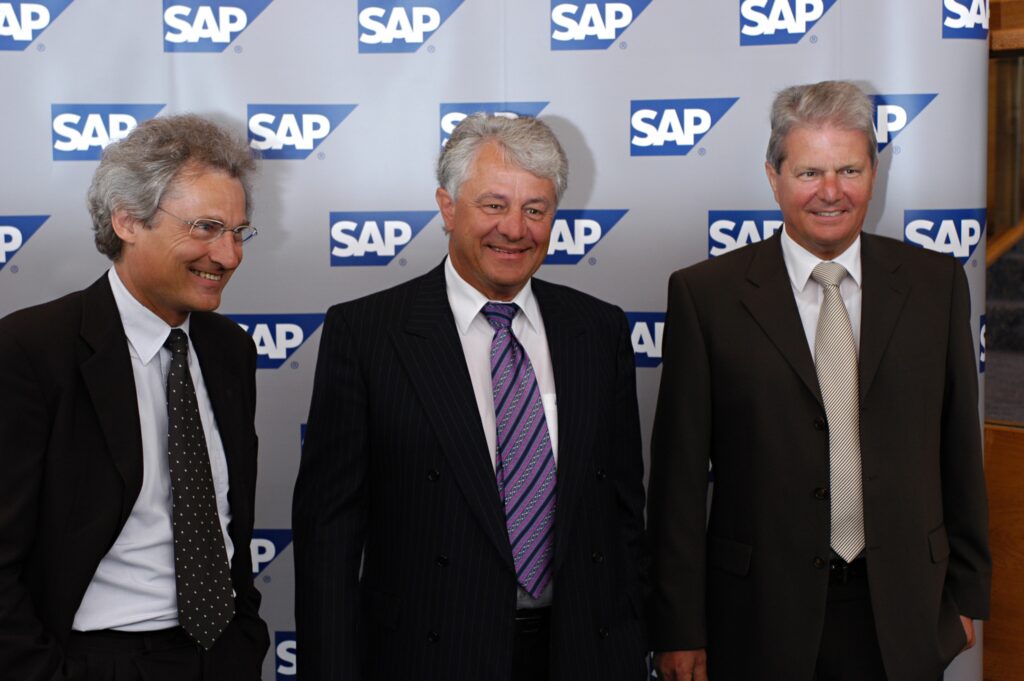
Though no longer its CEO, Plattner continued to channel his passion and his eye for technological trends into driving SAP forward, but now in his new role as chief software advisor on the Supervisory Board. That same year, he helped found the Hasso Plattner Institute of Design (“d.school”) at Stanford University, providing funds to support its work on design thinking, a new approach to finding creative solutions to complex problems.
2006: The In-Memory Database
It was in 2006 that Plattner and students at HPI began work on a revolutionary technology. The result was SAP HANA (High-Performance ANalytic Appliance), an entirely new, column-oriented, in-memory database management system.
“It’s not so easy for a big company to break out and do something radically different,” said Plattner. “The university context gives you the freedom to do it.”
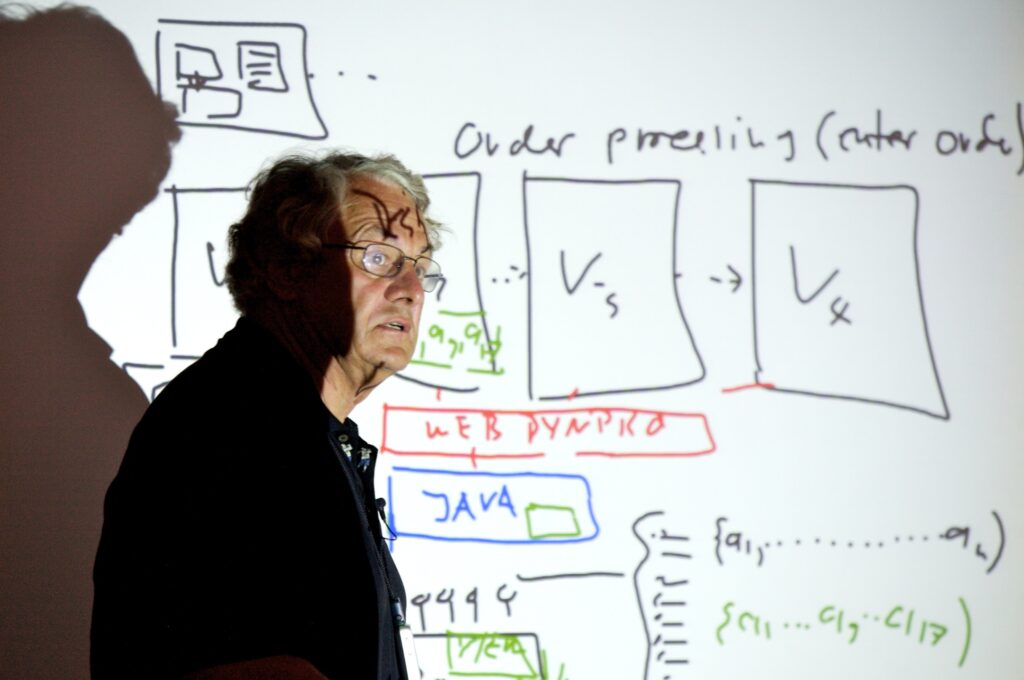
2011-2013: SAP HANA Drives Growth
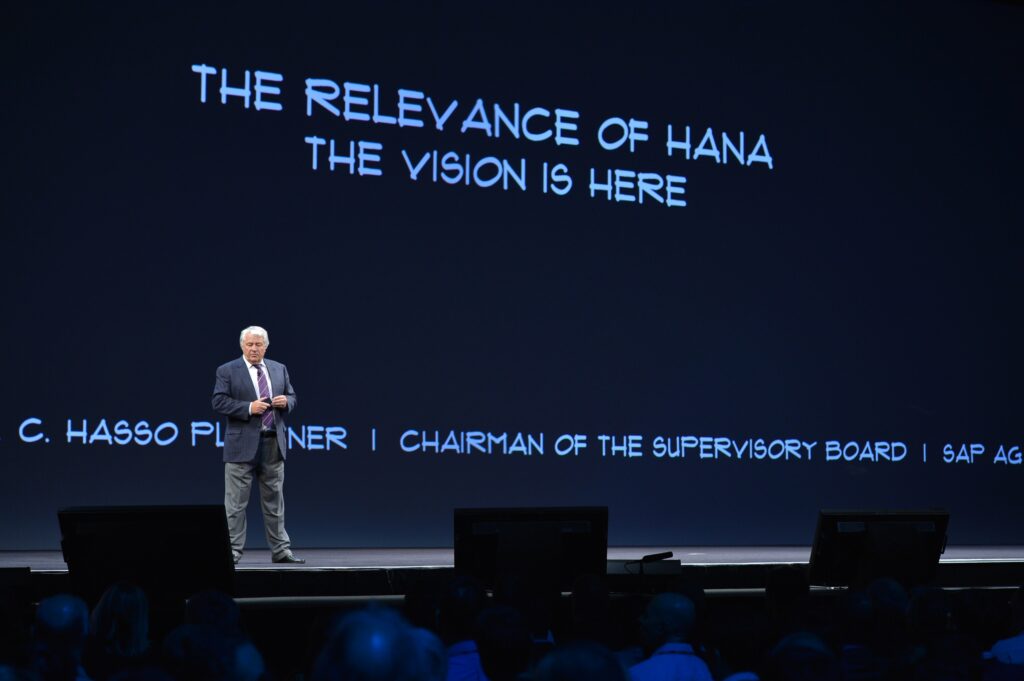
Five years later, the first SAP HANA customers began implementing the new database, which generated the kind of demand not seen since the market launch of SAP R/3.
By the end of 2013, the entire SAP Business Suite had moved to SAP HANA. In the three years since its launch, SAP HANA had garnered nearly €1.2 billion in revenues, making it one of the fastest-growing products in the history of enterprise software.
In an interview with German daily Handelsblatt in 2020, Plattner said: “SAP HANA is so superior in practice that there is no alternative. And quite honestly, it saved SAP’s life, because it let us massively accelerate our ERP system without a lot of changes, while physically downsizing it at the same time. That meant a huge cost saving for our customers.”
2015: The Foundation
Plattner reinforced his commitment to promoting education and culture by setting up the Hasso Plattner Foundation.
Among the many causes the foundation has supported over the years are programs to promote healthcare and health education in South Africa. The German city of Potsdam also has much to thank Plattner for: The Hasso Plattner Institute is the largest investment in Potsdam and the one that bears his signature most strongly. The Barberini Museum that he rebuilt completes the inner cityscape of Potsdam and provides a home for his impressive Impressionist collection — the largest outside of France. With the Kunsthaus MINSK, he saved one of the few architectural icons of the GDR era and created a home for his GDR art collection.

On being asked why he chooses to get involved with causes and projects of this kind, Plattner explained: “I owe the resources and skills for life to my parents and, above all, to my studies at the public technical university in Karlsruhe. That’s why I want to give something back in the area of education, so that others can also benefit from it.”
2022: Learn from Our Customers
In an interview to mark SAP’s 50th anniversary, Plattner shared some advice: “I recommend a return to the approach we used in the early days of SAP – of sending SAP teams out to the customer. Instead of implementing our standard systems, they should find out how people actually use the tools they get from SAP and other vendors. That will give us our starting point. There are so many interesting companies out there. We can learn from them and with them. We have to step outside SAP and do something with the customers.”
And in a comment directed to SAP employees, he said: “Treat the customers well – once we have them, we have to keep them. That’s one of SAP’s strengths. And never think it’s done. You have to carry on. The job is never done!”
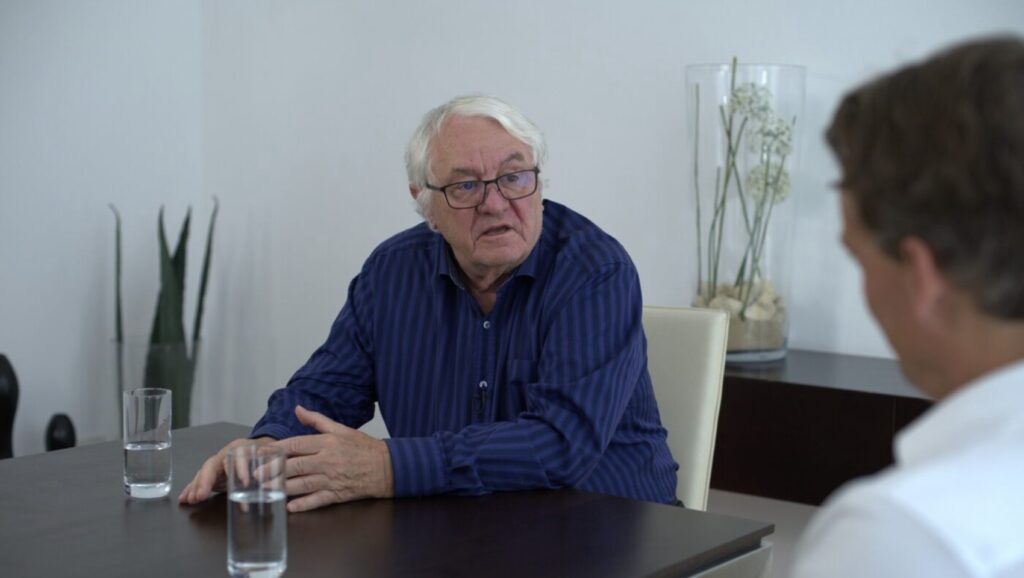
2024
Plattner will step down from the Supervisory Board on May 15, the last of the SAP co-founders to leave the company.



